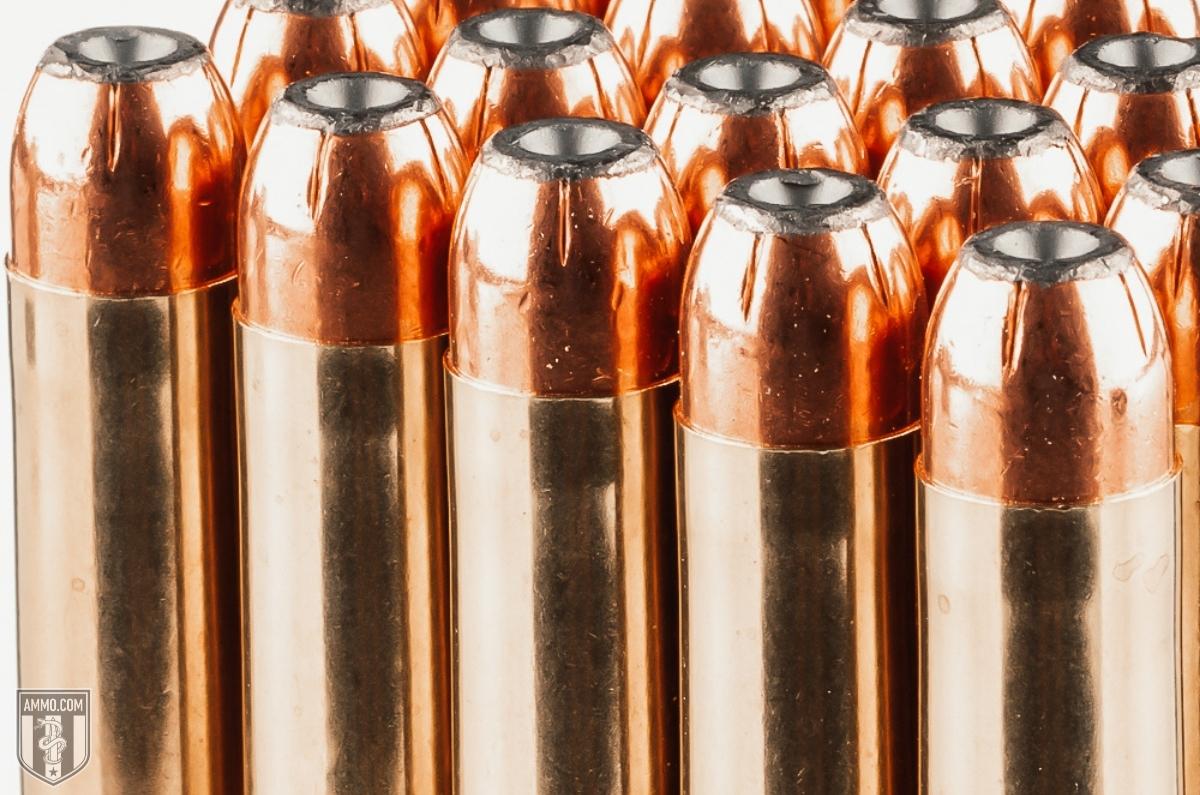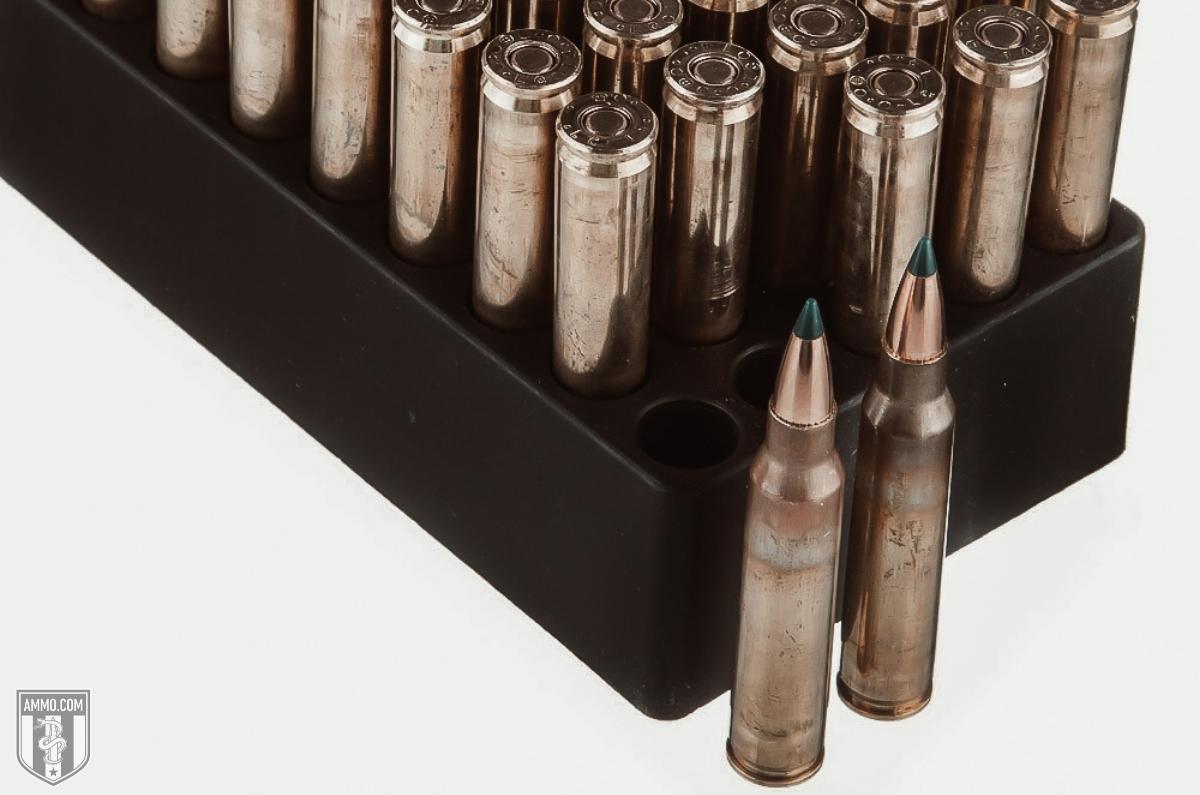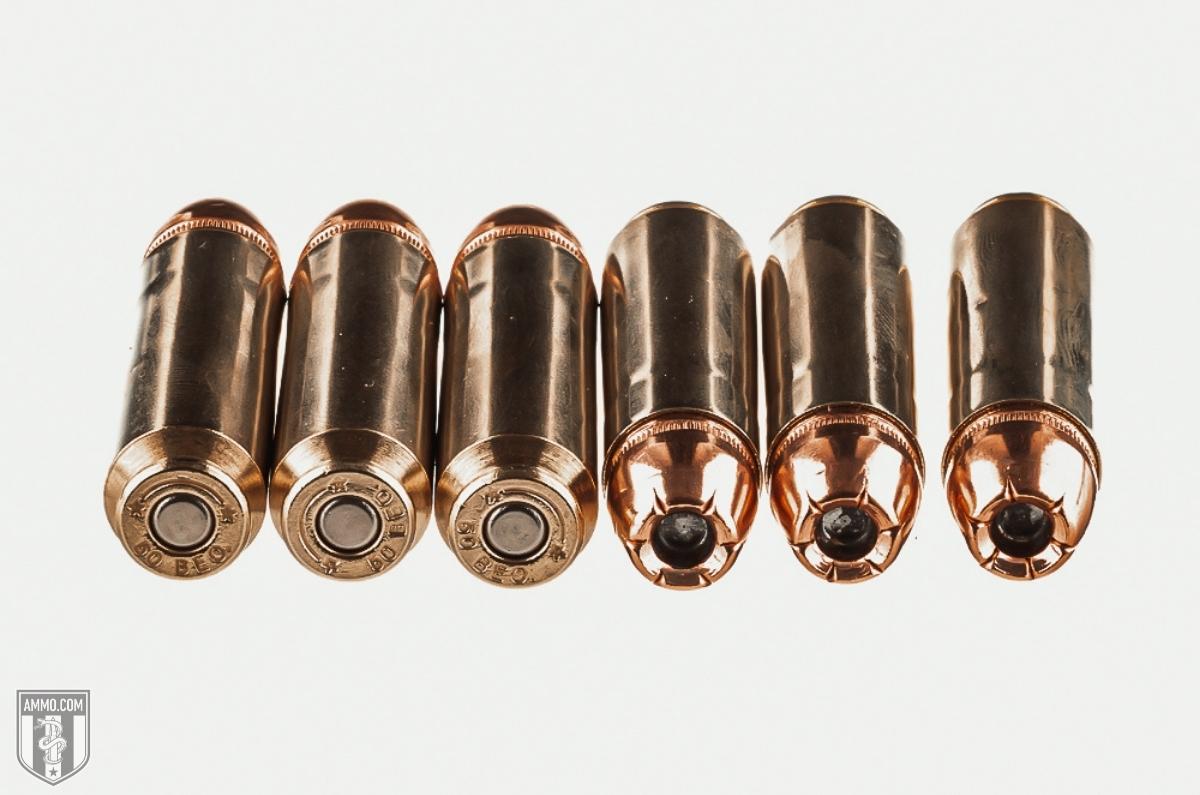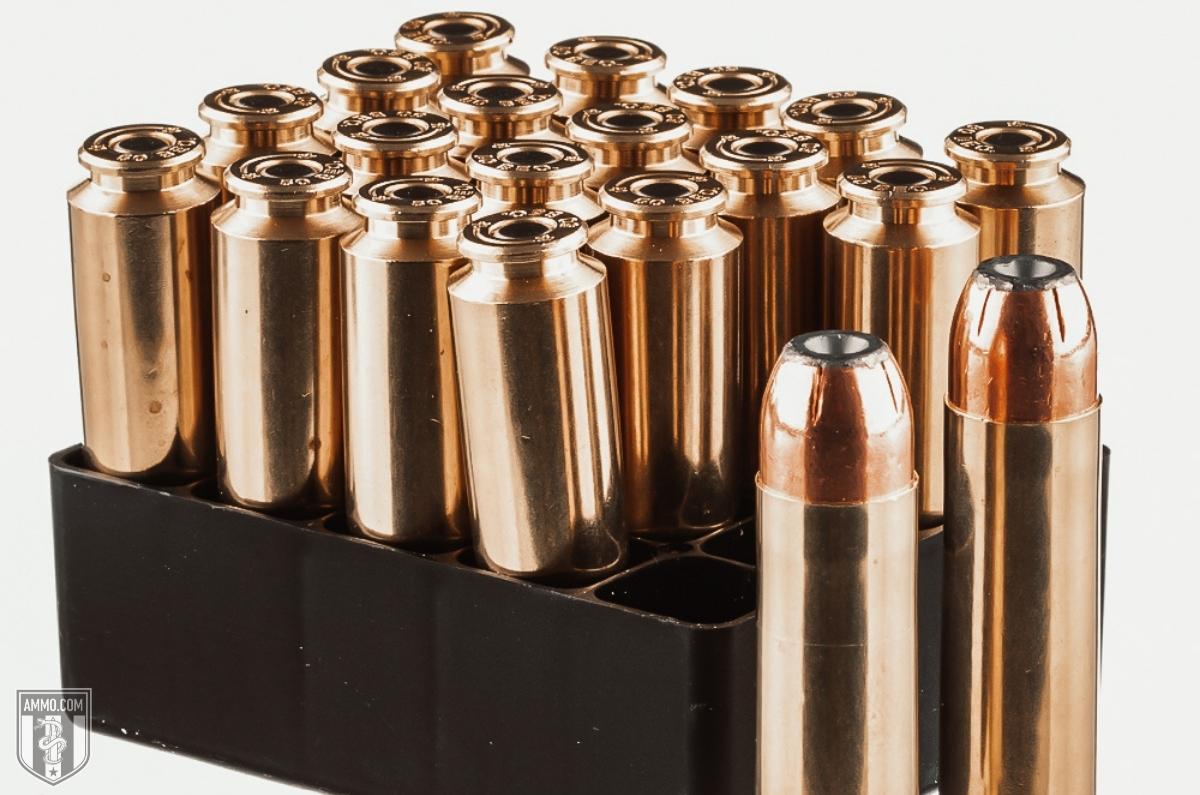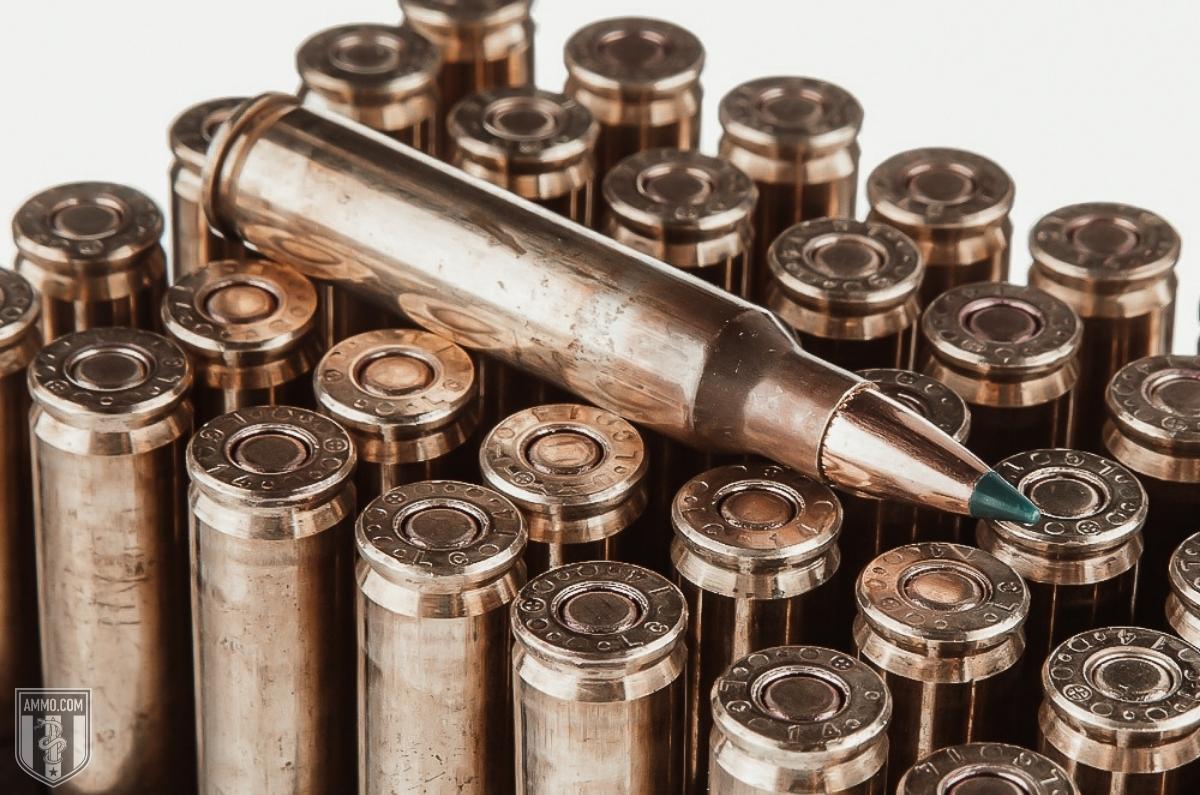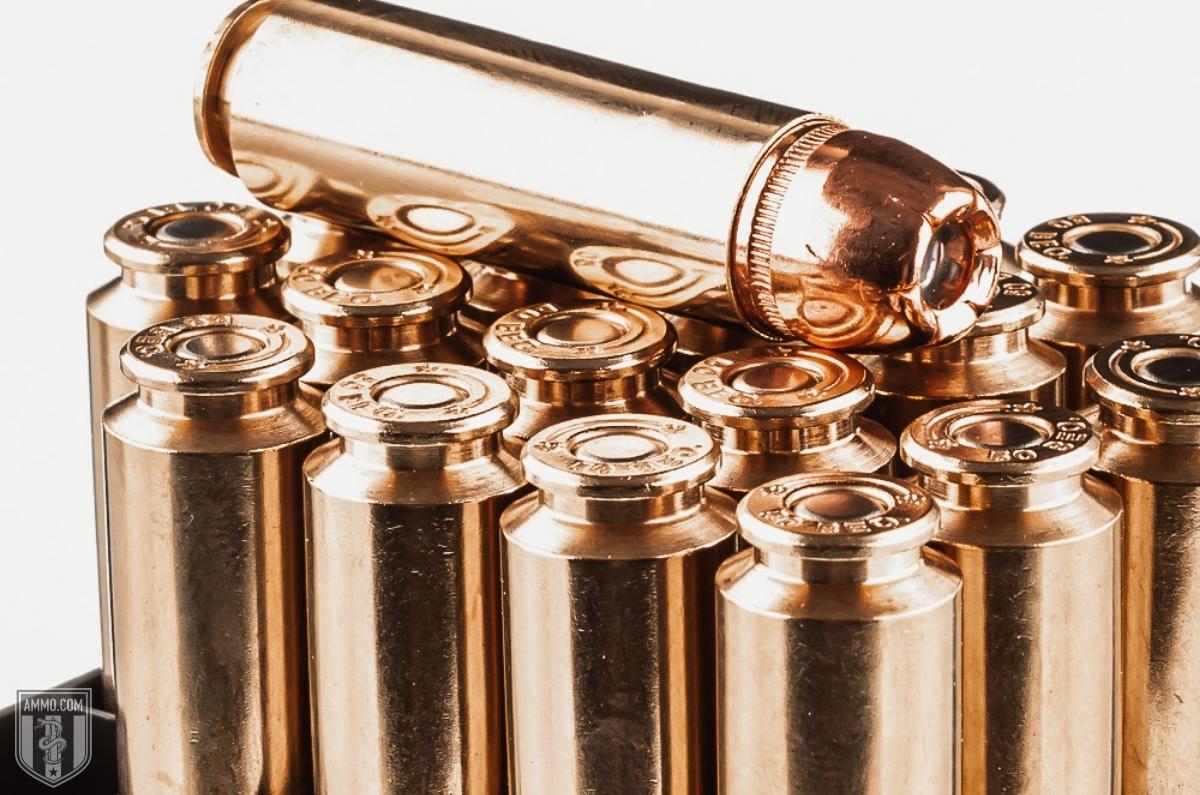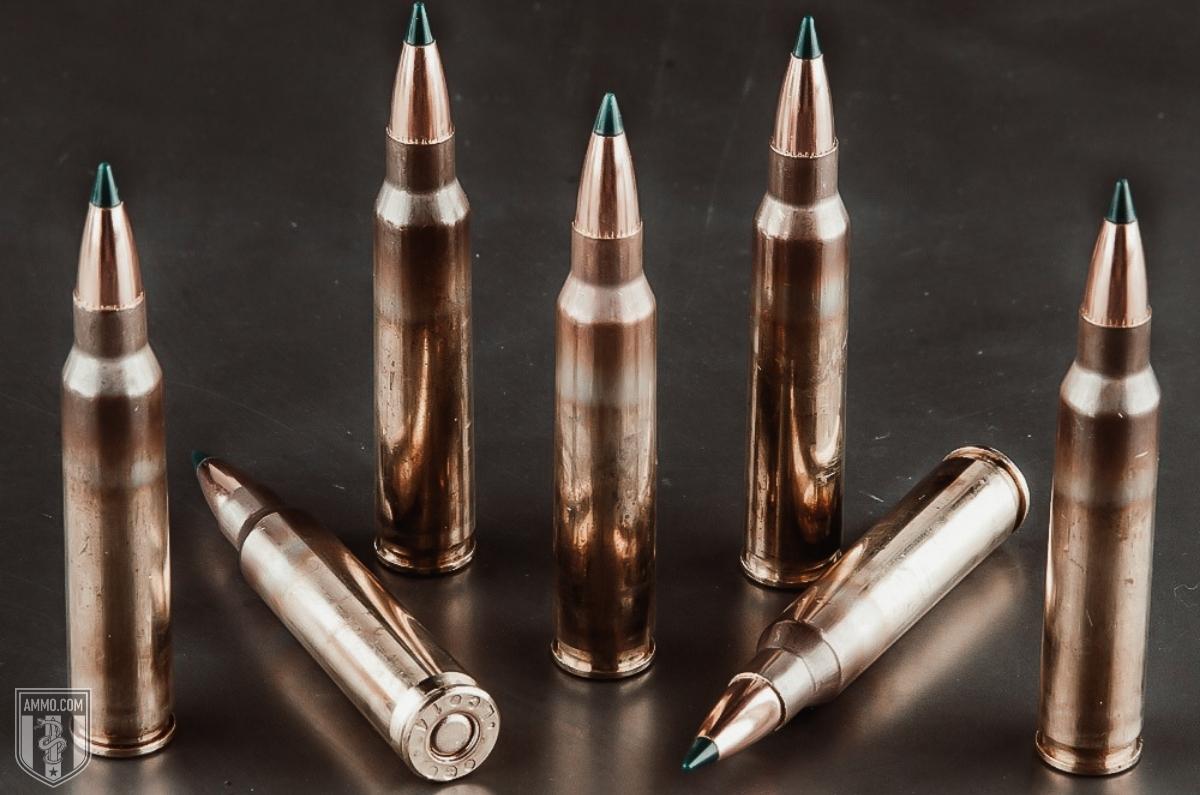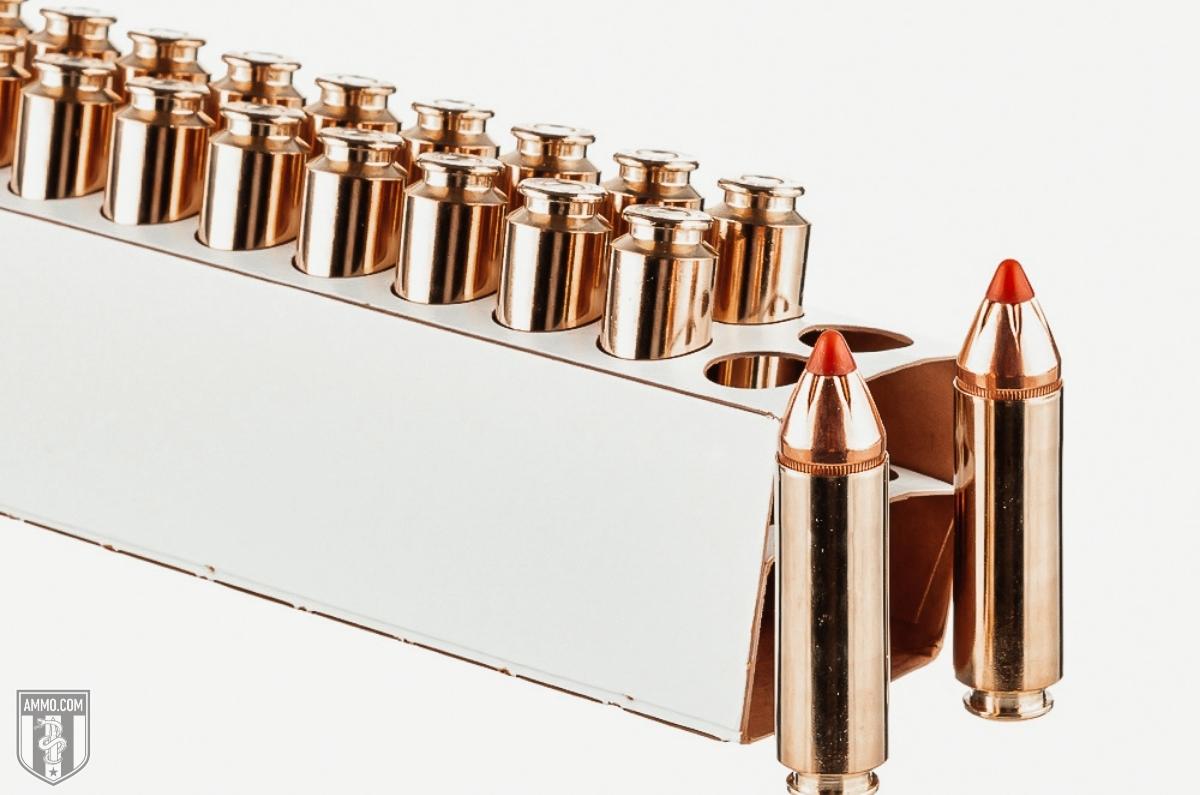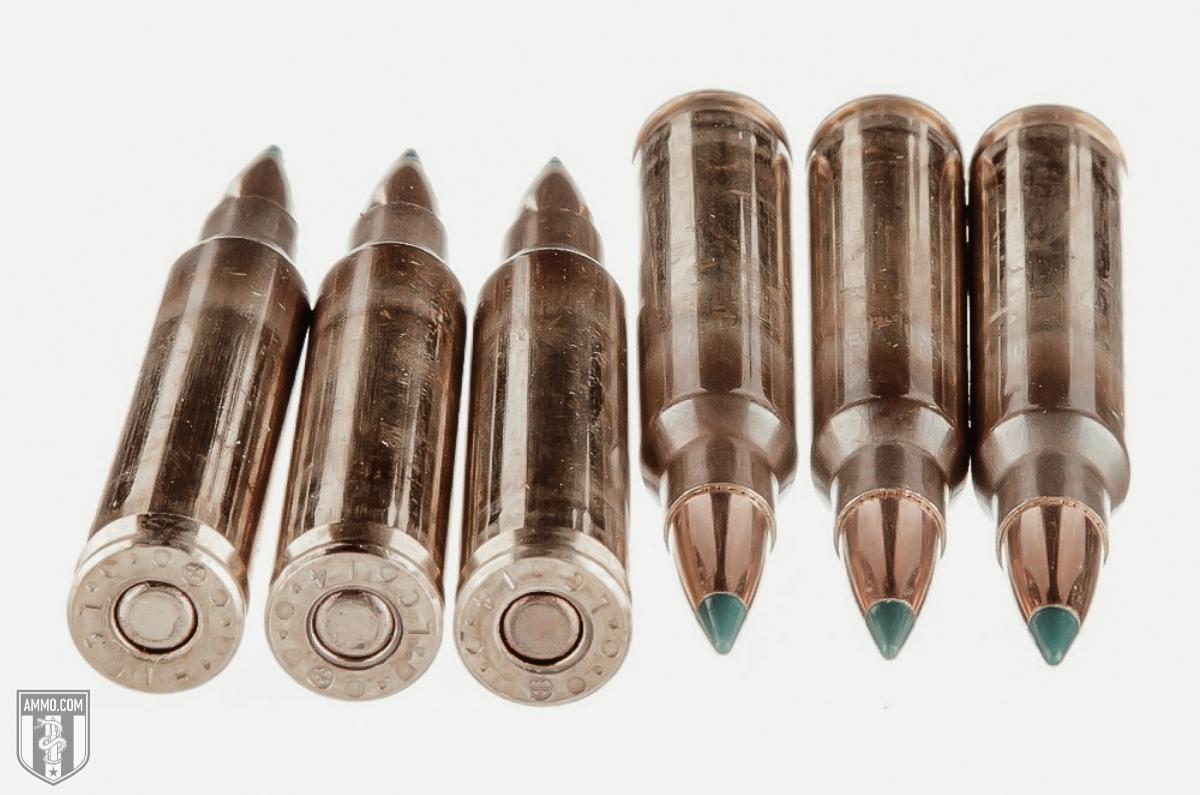50 Beowulf vs 5.56: When Stopping Power Matters
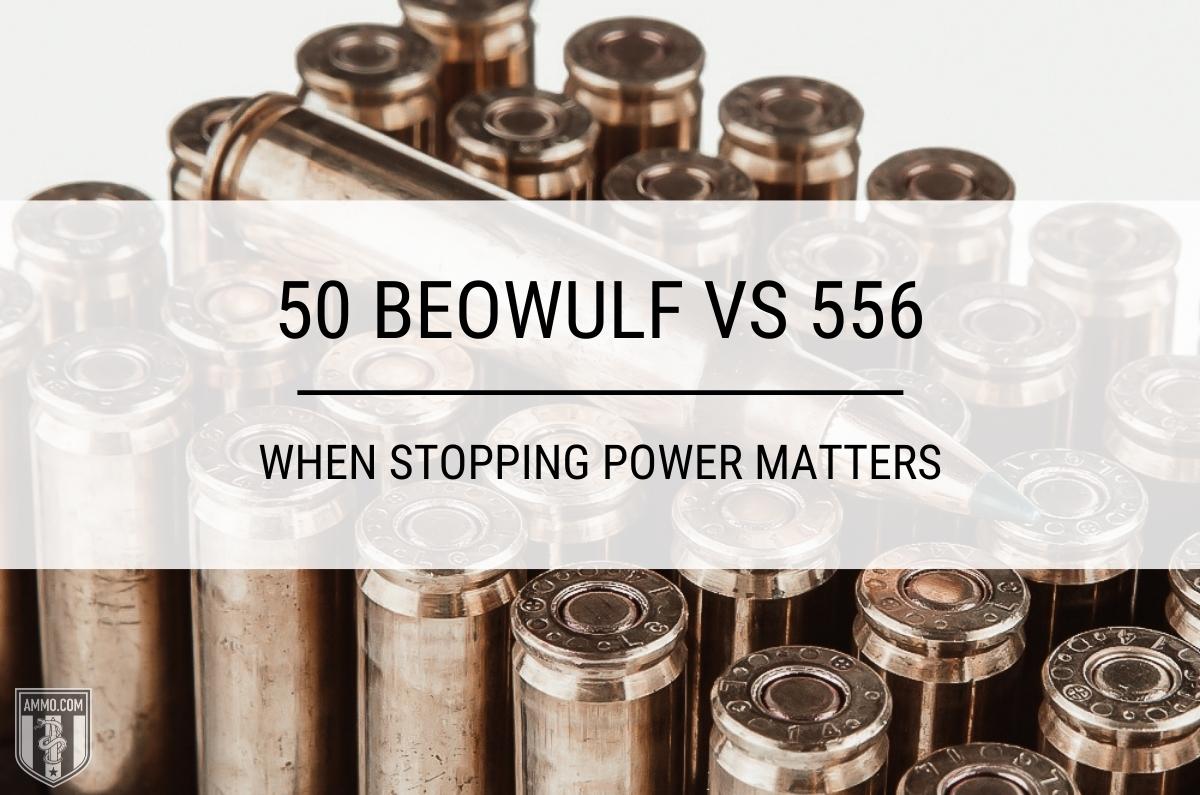
The standard AR-15 chambered in 5.56 NATO is truly America’s rifle and is a symbol of American ingenuity and freedom. Although the 5.56 NATO has proven itself in the jungles of Vietnam and deserts of Iraq, some gun owners wanted more performance out of their AR.
Adapting the AR-15 to different calibers is nothing new, as the 300 AAC Blackout, 6.5 Grendel, and 6.8 SPC are all popular choices that enhance the capability of the AR platform in different ways.
But some shooters wanted more stopping power, better terminal ballistics, and a rifle cartridge that could be used for both home defense and big game hunting.
The Alexander Arms .50 Beowulf (50 Beo for short) round is the answer that these gun owners were looking for, as its heavier bullets can deliver bone-crushing kinetic energy that can stop feral hogs or whitetail in their tracks with a single shot.
However, is investing in a big bore AR 50 Beowulf upper receiver really worth it? Or is it better to stick with the AR-15 platform mainstay, the 5.56 NATO?
In this article, we will evaluate the .50 Beowulf vs 5.56 NATO to help you understand the differences between the two and give you a clearer idea of which cartridge is best for your shooting needs.
What is the difference between 50 Beowulf and 5.56?
The differences between 50 Beowulf vs 556 is the bullet diameter each cartridge fires, intended engagement ranges, and kinetic energy. The 50 Beowulf fires a 0.50” diameter bullet that is intended for close-range engagements while the 5.56 fires a 0.224” diameter bullet that excels at long-range shots. The 50 Beowulf also hits with considerably higher kinetic energy than the 556.
A Note on Nomenclature
Please note that within this article we will refer to the 223 Remington (223 Rem) and the 5.56x45mm NATO round interchangeably. There are differences between the two and you can read about them in this article: .223 vs 5.56
In short, a 223 Rem can safely be fired from a rifle or handgun chambered in 5.56, however the opposite is not true.
Cartridge Specs
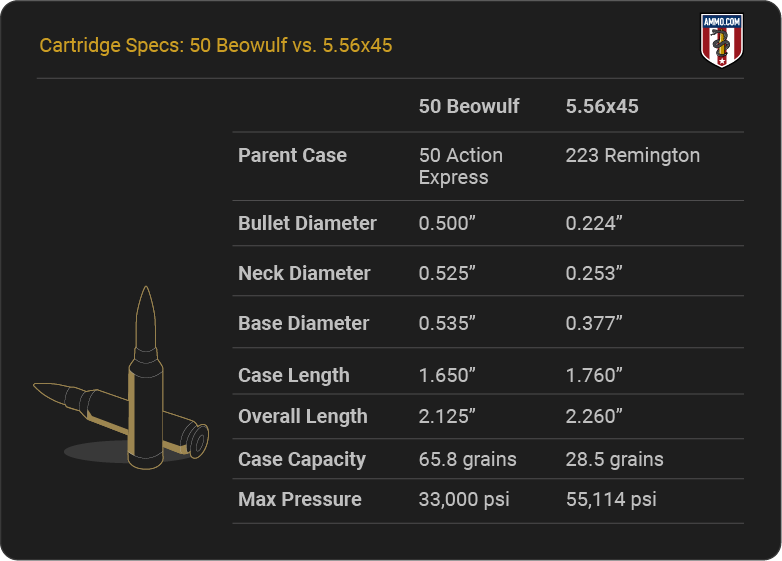
When evaluating centerfire rifle cartridges, it’s a good idea to analyze the cartridge specs to gain more knowledge of each.
The most noticeable difference between these two cartridges is the bullet diameter each round fires. The 5.56 NATO fires the smaller 0.224” bullet diameter while the 50 Beo fires a massive 0.50” diameter bullet. The 5.56 is capable of firing bullets between 35-90 grains with the 55 and 62 gr bullet weights being the most common. The 50 Beowulf, on the other hand, fires extremely heavy bullets ranging between 200 and 600 grains, though 335, 350, and 400 gr bullet weights being the most common.
Developed in 2001 by Alexander Arms, not much is known about the genesis of the 50 Beowulf as Bill Alexander is known for keeping company matters a closely guarded secret. A lengthened 50 Action Express, or 50 AE, extended to 1.65” was utilized for the 50 Beowulf. The 50 AE is most well-known for being the primary chambering of the Desert Eagle handgun.
In contrast, the 5.56 NATO was developed in 1980 by FN Herstal using the 223 Remington (M193) as a parent cartridge. The 5.56 and 223 Rem have the same external case dimensions, but the new 5.56x45mm NATO round was designed to fire a heavier 62-grain bullet that required a faster 1:7 twist rate barrel for bullet stabilization.
Another major difference between the 5.56 vs 50 Beowulf is that the 50 is a straight wall cartridge design while the 5.56 uses a more traditional bottleneck case. A straight-walled cartridge is necessary for deer hunting in Midwest states like Ohio, Iowa, Indiana, and Michigan while the bottlenecked design aids in reliable feeding.
The 50 Beowulf also uses rebated rim design, meaning their rim is narrower than their cartridge base, while the 5.56 is a rimless design. The Beowulf has a 0.447” diameter rim which is the same as another round made by Alexander Arms, the 6.5 Grendel as well as the Russian 7.62x39mm fired by the AK-47.
Although noticeably smaller, the 5.56 case is the longer of the two at 1.76” compared to 1.65” for the Beowulf. However, the overall length of each cartridge is nearly identical at 2.26” for the 5.56 and 2.25” for the 50 Beowulf.
One massive difference between these two cartridges is their case capacity. Although cases are typically never loaded to the brim, the 50 Beowulf can hold a massive 65.8 gr of powder compared to 28.5 gr for the 5.56. That’s over double the case capacity for the 50 Beowulf, which it needs to fire its considerably heavier bullets at acceptable velocities.
The final difference between these cartridges is their maximum chamber pressures. The 5.56 can handle slightly over 55,000 psi per SAAMI specs, however the 50 Beowulf is not a certified cartridge. As the “50 Beowulf” name is trademarked by Alexander Arms, SAAMI will not certify the cartridge to avoid any potential trademark litigation. To squirm around this potential legal issue, some ammo manufacturers will brand their 50 Beowulf ammo by its metric designation, 12.7x42mm.
Recoil
The 5.56 NATO has considerably less recoil than the 50 Beowulf.
Recoil is an important consideration when purchasing a new rifle as a round with heavy recoil will be more difficult to control and will slow your rate of follow up shots.
Recoil is affected primarily by muzzle velocity (FPS), powder charge, bullet weight, and rifle weight.
To provide a clean “apples to apples” comparison, a standard AR-15 carbine weight (7.5 lbs) will be used for each calculation. This may not be completely accurate in terms of real-world experience, as 50 Beowulf rifles are generally a little heavier than standard 5.56 rifles.
However, on average the 5.56 NATO has a free recoil of around 4.5 ft-lbs compared to a shoulder-slapping average of 30 ft-lbs for the 50 Beowulf. That’s more than a 6x difference between the two cartridges which is why many 50 Beowulf upper receivers come factory equipped with a muzzle brake.
There’s a reason why Lt. Col. Jeff Cooper coined cartridges like the 50 Beowulf “thumper rounds”, because they will definitely “thump” your shoulder when you squeeze the trigger!
Muzzle Velocity, Kinetic Energy, and Trajectory
Cooper defined the “Thumper concept” as a cartridge designed to be fired from the semi-auto AR-15, had an effective range around 250 yards, was 44-caliber or larger, and could harvest large game with one shot. The three most popular Thumper rounds being the 450 Bushmaster, 458 SOCOM, and 50 Beowulf.
You can read about how these three cartridges compare in this article: 450 Bushmaster vs 458 SOCOM vs 50 Beowulf
The 50 Beowulf definitely meets the criteria set forth by Lt. Col. Cooper, but how does it stack up against 5.56 ballistics?
For this comparison, we will look at two popular factory loads for each cartridge. For the 5.56 we will compare the most prevalent NATO rounds available on the market in the M193 55 gr FMJ as well as the M855 (SS109) 62 gr FMJ. For the 50 Beowulf, we will analyze two popular self-defense rounds from Underwood Ammo, the 350 gr Hornaday XTP hollow point as well as the 420 gr Lehigh Xtreme Penetrator.
In terms of muzzle velocity, the lighter bullets of the 5.56 dominate the 50 Beowulf by a commanding margin. The M193 round leaves the muzzle at 3,240 fps and the M855 at 3,060 fps compared to 1,775 and 1,650 fps for the 350 gr and 420 gr 50 loads, respectively. To put this in perspective, both 556 loads have higher velocity at 400 yards than the 50 Beowulf has at the muzzle.
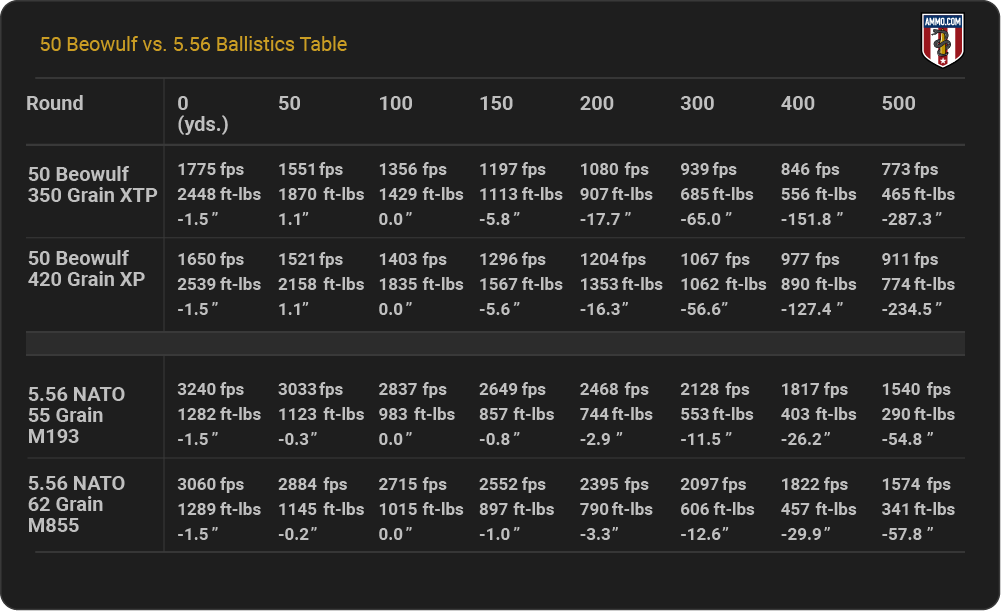
Another attribute the 5.56 is well-known for is its long range capability and flat trajectory thanks to its white hot muzzle velocity. At 500 yards both 556 offerings have experienced less than -60” of bullet drop, while at 300 yards the 50 Beo loads are approaching (or below) the supersonic barrier and have dropped more than the 556 loads.
Based on the observations above, it’s clear that the 50 Beowulf is not designed for long range shooting. However, what it IS designed for is short range stopping power, and we see this in the massive difference in muzzle energy between the four rounds. At the muzzle, both 5.56 loads have just short of 1,300 ft-lbs of energy, but the 50 Beowulf cartridges have nearly double this at 2,448 and 2,539 foot-pounds of kinetic energy for the 350 gr XTP and 420 gr Lehigh, respectively. The 50 is also more effective at conserving that kinetic energy over distance, surpassing the 556 over all measured ranges in the table above.
Given all this ballistic data, what conclusions can we draw about the .50 Beowulf vs 5.56?
The muzzle velocity of 5.56 ammo makes it a potent long range shooting cartridge with a flat trajectory. Many shooters list the 556 effective range around 500 yards, while the 50 cal Beowulf round starts to fall off near 200 yards. Although the kinetic energy of the 50 Beowulf is massive, the round goes subsonic around the 200–300 yard mark depending on the bullet design.
This suggests that the 50 Beowulf is best utilized in short range situations where high levels of kinetic energy are preferred, while the 556 is more effective for long range shooting.
Ballistic Coefficient and Sectional Density
Ballistic coefficient (BC) is a measure of how aerodynamic a bullet is and how well it will resist wind drift. Sectional density (SD) is a way to evaluate the penetration ability of a bullet based on its external dimensions, design, and weight.
Although the 50 Beowulf cartridge fires considerably heavier bullets, the 62 gr 5.56 FMJ has the highest ballistic coefficient at 0.274. The M193 bullet measures in at 0.243 while the 420 gr Lehigh Penetrator has a BC of 0.25 and the 350 gr XTP has the lowest BC at 0.15.
The difference in BC is primarily due to the differences in bullet design between the two rifle cartridges. The bullets fired by the 50 Beowulf are relatively short as they are constricted by the overall length restriction of 2.26" due to the AR-15 magazine designs. This means the 50 cannot use slender and more aerodynamic bullets that would have a higher BC since they wouldn’t fit in the magazine. The 5.56, on the other hand, can fire more aerodynamic bullet thanks, in part, to its bottleneck case.
Although the 50 Beowulf bullets might not be the most aerodynamic, they hit hard and penetrate deep giving them an edge in sectional density. The Lehigh Penetrator 420 gr bullet has the highest SD of the four at 0.24 while the 350 gr XTP has a SD of 0.20. The 5.56 comes up a little short on sectional density, as the 55 gr FMJ has a SD of 0.157 and the 62 gr SS109 has a SD of .177.
Hunting
The 5.56 is an excellent varmint hunting cartridge while the 50 Beowulf was built with big game hunting in mind.
The civilian version of the 5.56, the 223 Remington, has long been considered one of the staple varmint hunting rounds available on the market. Its incredibly low recoil, flat trajectory, and low cost per round make it ideal for popping prairie dogs or woodchucks at distance, and coyotes stand no chance against hunting bullets like the 223 Rem Sierra BlitzKing or Nosler Varmageddon. The lighter bullets of the 5.56 also make it ideal for preserving the pelt and meat of small game, should you enjoy processing your quarry fully.
Although the 50 Beowulf can be used for varmint hunting, its limited effective range and arching trajectory past 250 yards makes it more difficult to use. Furthermore, the 200+ grain weight bullets are typically considered a bit too much for varmints, plus they are rather expensive.
The 50 Beowulf might not be the best for varmint hunting, but when it comes to big game hunting it is hard to beat. The massive amount of kinetic energy the 50 produces is more than enough to take down whitetail, mule deer at medium-range while elk can be taken at closer distances. The Beowulf cartridge was also designed to satisfy the straight wall cartridge requirement of several Midwest states for hunting deer.
The Beowulf has also gained a lot of traction in the hog hunting community, as it has the kinetic energy needed to drop hogzilla with a single shot and allows for relatively quick follow up shots when fired from the AR-15 platform with a muzzle brake. Feral hogs are a real issue to farmers, as a herd of hogs can destroy an entire field in a single night.
It is a point of contention in the hunting community if 223 Remington/5.56 NATO is suitable for whitetail, as many states prohibit the use of 223 for deer. However, the heavier bullet options for 223 such as the 75 and 77 grain varieties have been shown to be very effective against large game with proper shot placement.
The 5.56 is ill-suited for elk as it lacks the kinetic energy needed to ethically harvest these large game animals.
Generally, the 5.56 makes for an excellent small game and varmint hunting cartridge while the 50 Beowulf is better for large game.
Home Defense/Self-Defense
Both the 5.56 and 50 Beowulf make excellent choices for your home defense carbine. A light weight AR-15 rifle or pistol with a shorter barrel length would make a formidable self-defense weapon in close quarters like those experienced in the home.
Although the 50 Beowulf offers incredible kinetic energy at the muzzle, it’s propensity to over penetrate should give shooters pause when using it for self-defense. The last thing any responsible citizen wants is for their bullets to penetrate through the bad guy and potentially strike an innocent bystander.
One other downside to the 50 Beowulf is reduced magazine capacity. Although the 50 can fit into a standard AR-15 magazine, it cannot double stack like the 5.56 as the Beowulf case is so much wider than the 5.56’s. Therefore, 50 Beowulf rounds have to single stack vertically in the magazine, reducing its capacity to 10-rounds compared to 30-rounds for 5.56.
Although the 50 Beowulf as an extremely potent round and will be more than powerful enough in any home defense situation, the 5.56 makes for a better home defense round as it penetrates less. Furthermore, there are more ammo options available for the 5.56 that use an expanding tip, that further limits over penetration and are specifically geared for self-defense.
Ammo and Rifle Cost/Availability
Ammo and rifles for the 5.56 are relatively inexpensive and easy to come by.
As one of the most popular centerfire rifle cartridges in North America, the 5.56 NATO is by far the least expensive round of the two. Virtual every ammo manufacturer, like Winchester, Remington, Hornady, Federal, and PMC, has at least one offering 5.56 ammo. This popularity helps keep costs down which makes the 5.56 a great plinking round.
Factory ammo for 556 is easy to find at almost any place that sells firearms or ammo, whereas 50 Beo will be much for difficult to source at your local stores. Inexpensive FMJ 556 plinking ammo can be had for around $0.45/round while premium hunting ammo will typically cost around $1-2/round. You can also purchase 5.56 bulk ammo to increase your overall cost savings per round.
Most of the factory ammo for 50 Beowulf comes from Alexander Arms as they hold the trademark on the cartridge name. However, custom ammo manufacturers often make their own 50 Beowulf loads under the metric designation 12.7x42mm. Factory ammo from Alexander Arms will run you around $1.70/round while custom ammo for hunting or personal defense will typically cost around $3/round.
In terms of rifle availability and price, the 5.56 NATO cannot be beat as the AR-15 is the most popular rifle in America. The vast majority of AR-15’s produced are chambered in 5.56, so your rifle options are extensive.
When looking for a bolt-action 5.56 rifle, you’ll quickly discover that most of them are chambered in 223 Rem and not 5.56. As the 223 Remington is marketed primarily as a varmint round, it holds a very large market share in the bolt-action rifle space. However, remember that it is not safe to fire 5.56 ammo in a 223 rifle as we discuss in this article HERE.
If you really want a bolt action rifle in 5.56, there are a few options available like the Ruger American Ranch, the Ruger GUNSITE Scout, and Mossberg MVP Patrol. Neither cartridge is well suited for use in a lever action rifle.
Factory produced 50 Beowulf AR-15 rifles are predominantly available from Alexander Arms due to their copywrite. Alexander Arms is also the primary supplier of all parts and upper receivers for the 50 Beowulf as well, though Bear Creek Arsenal (BCA) is another option at a lower price point.
However, thanks to the modularity of the AR-15 platform, any 5.56 AR-15 can easily be converted to 50 Beowulf by swapping the upper receiver. This means you can have one AR155 lower receiver and two different uppers, allowing you to shoot two different calibers from the same rifle.
Reloading
If you like to handload your own ammo, both cartridges offer you a lot of options for customization in terms of projectiles and powders to make the perfect reloads for your AR-15 rifle.
The 5.56 will be the easier cartridge to handload for, as once fired brass, inexpensive FMJ bullets, and powders are easy to find. Bullets for the 5.56 are plentiful can also be used for other 0.224” caliber cartridges such as the 22-250 Remington, 220 Swift, and 224 Valkyrie.
It should also be noted that there are no resizing dies made for 5.56 NATO and only 223 reloading dies are available. As the 5.56 and 223 Rem have the same external case dimensions, a 223 die will do just fine resizing your 5.56 brass.
Reloading for the 50 Beowulf is one method that shooters will use to reduce their overall cost per round and get around the spotty availability of factory ammo. Brass will be more difficult to come by for the 50 Beowulf as fewer companies produce it. Bullets for the 50 Beowulf can also be used to reload larger handgun cartridges like the 500 S&W Magnum revolver round, the 50 AE, or the 50 GI which is a boutique Glock conversion caliber.
Overall, reloading for the 5.56 will be easier as components are readily available, however handloading for the 50 Beowulf is one way to reduce your overall cost per round and maintain a steady ammo supply.
Final Shots: 5.56 vs 50 Beowulf
The 5.56 NATO and 50 Beowulf are two excellent centerfire rifle cartridges that are perfectly suited for the AR-15 rifle. Even though both cartridges are fired from the same rifle system, the 5.56 and 50 Beowulf fill very different shooting roles.
The 5.56 NATO is a battle-proven round and is ideal for long range target shooting, varmint hunting, and general plinking. It’s inexpensive, easy to buy in bulk, and has low recoil for an enjoyable shooting experience.
But you must admit that there’s something special about a 50-caliber bullet. It commands respect, oozes power, exudes kinetic energy, and laughs at barriers. So, if you’re looking for a big bore AR that can take down hogs, whitetail, and big game with a single shot, then you should give the Alexander Arms .50 Beowulf serious consideration.
Most shooters will go with the readily available 5.56 NATO cartridge, as ammo is inexpensive and easy to find. However, the beauty of the AR-15 is that you don’t have to dedicate yourself to a single cartridge, as an AR15 lower can easily be attached to a different upper receiver, and you can be shooting a new caliber in moments. So, if you want to shoot 50 Beowulf, just grab yourself a dedicated upper receiver and enjoy the power that the 50 grants you.
No matter which cartridge you choose, make sure you stock up on ammunition here at Ammo.com and I’ll see you on the range!
Ammo Comparisons
- .308 vs 5.56
- 6.5 Creedmoor vs .308
- .300 Blackout vs .308
- .300 Win Mag vs .308
- .243 vs .308
- .308 vs .30-06
- 7mm-08 vs .308
- .270 vs .308
- 7.62x39 vs .308
- .223 vs .308
- .338 Lapua vs .308
- .380 ACP vs 9mm
- .223 vs 5.56
- .300 Blackout vs 5.56
- 9mm vs 45 ACP
- 9mm vs 40 S&W
- .357 SIG vs 9mm
- 10mm vs 9mm
- 9mm vs 9mm Luger
- .243 vs .270
- .300 Win Mag vs .30-06
- .270 vs .30-06
- .40 vs .45
- 38 Special vs 357
- 9mm vs 40 vs 45
- 5.56 vs 7.62x39
- 338 Lapua vs .30-06
- .30-30 vs .30-06
- 300 PRC vs 338 Lapua
- .30-06 vs 7mm
- 300 Win Mag vs 338 Lapua
- 300 PRC vs 300 Win Mag
- 300 WSM vs 300 Win Mag
- 338 Win Mag vs 338 Lapua
- 12 Gauge vs 20 Gauge
- 10mm vs 357 Mag
- .30-30 vs 7.62x39
- 224 Valkyrie vs 22-250
- 17 HMR vs 22 Mag
- 7.62x39 vs .300 Blackout
- 45 ACP vs 45 Auto
- 45-70 vs 30-30
- 300 Blackout vs 223
- 357 Magnum vs 9mm
- 350 Legend vs 300 Blackout
- 224 Valkyrie vs 223
- 45 ACP vs 38 Super
- 6.5 Grendel vs .308
- 17 HMR vs 22 LR
- 10 Gauge vs 12 Gauge
- 22-250 vs 223
- 45 Colt vs 45 ACP
- 350 Legend vs 30-30
- 5.7x28 vs 223
- 5.7 vs 9mm
- 5.56 vs 5.7
- 22 vs 9mm
- Buckshot vs Birdshot
- 450 Bushmaster vs 308
- 450 Bushmaster vs 223
- Buckshot vs Slug
- 6.5 Grendel vs 5.56 vs 223
- 6mm ARC vs 6.5 Grendel
- 44 vs 45
- 458 SOCOM vs 5.56
- 357 vs 44
- 32 ACP vs 380
- 300 Win Mag vs 338 Win Mag vs 338 Lapua Mag
- 450 Bushmaster vs 458 SOCOM vs 50 Beowulf
- 6mm Creedmoor vs 6.5 Creedmoor
- TMJ vs FMJ
- 44 Special Vs 44 Magnum
- 45 90 vs 45 70
- 6.8 Western vs 6.8 SPC
- 50 Beowulf vs 50 BMG
- 26 Nosler vs 6.5 PRC
- 28 Gauge vs 410
- 6.8 SPC vs 5.56
- 6.8 SPC vs 6.5 Grendel
- 6.8 Western vs 7mm Rem Mag vs .28 Nosler
- 6.8 Western vs 6.5 Creedmoor
- 22 Hornet vs 223
- 6.8 Western vs 6.5 PRC
- .410 vs 12 Gauge
- .410 vs 20 Gauge
- 22 LR vs 22 Mag
- 6mm ARC vs 243
- 7mm-08 vs 270
- 243 vs 6.5 Creedmoor
- Nickel vs Brass Casing
- 204 Ruger vs 223
- 50 Beowulf vs 5.56
- 260 Remington vs 6.5 Creedmoor
- 6mm Remington vs 243
- 28 Nosler vs 300 PRC
- 50 Beowulf vs 50 AE
- 22 Nosler vs 22-250
- 450 Marlin vs 45-70
- 300 Win Mag vs 300 Norma
- 458 SOCOM vs 300 Blackout
- 38-55 vs 45-70
- 22 Hornet vs 22 LR
- 300 Norma vs 338 Lapua
- 338 Lapua vs 50 BMG
- 28 Nosler vs 300 Win Mag
- 28 Nosler vs 6.5 Creedmoor
- 204 vs 22-250
- 458 SOCOM vs 45 70
- 44 40 vs 45 70
- 6.8 SPC vs 6.5 Creedmoor
- 450 Bushmaster vs 30-06
- 7mm Rem Mag vs 300 Win Mag
- 30 Carbine vs 223
- 25-06 vs 30-06
- 26 Nosler vs 28 Nosler
- 16ga vs 12ga
- 30 06 vs 7.62 x54R
- 9mm Makarov vs 9mm Luger
- 350 Legend vs 223
- 30 Carbine vs 5.56
- 6.5x55 vs 6.5 Creedmoor
- 6.5 Creedmoor vs 270 vs 25-06
- M193 vs M855
- 450 Bushmaster vs 458 SOCOM
- 6.5 Grendel vs 6.5 Creedmoor
- 350 Legend vs 5.56
- .277 Fury vs 6.8 SPC
- 277 Fury vs 300 Win Mag
- 10mm vs .45 ACP
- 277 Fury vs 223
- 6.8 SPC vs 300 Blackout
- 6.5 PRC vs 6.5 Creedmoor
- 277 Fury vs 308
- 277 Fury vs 6.5 Creedmoor
- 350 Legend vs 450 Bushmaster
- 277 Fury Vs 5.56 NATO
- 10mm vs 40S&W
- 32 ACP vs 9mm
- 32 Special vs 9mm
- 8.6 Blackout vs 300 Blackout
- 30 Super Carry vs. 9mm
- 5.56 vs 9mm
- .50 Action Express vs 9mm
- 7.62x25 vs. 9mm
- 10mm vs 44 Magnum
- 300 Blackout vs 300 Win Mag
- 6.5 Grendel vs 300 Blackout
- 460 Rowland vs 10mm
- 300 RUM vs 300 PRC
- 300 Norma vs 300 PRC
- 45 GAP vs 45 ACP
- 7mm PRC vs 300 Win Mag
- 300 PRC vs 6.5 Creedmoor
- 300 PRC vs 308
- 357 SIG vs 357 Mag
- 7.62x39 vs 7.62x51
- 243 Win vs 223 Rem
- 30 Nosler vs 300 PRC
- 6.5 Creedmoor vs. 30-06 Springfield
- 450 S&W vs. 44 Magnum
- 6.5 Creedmoor vs. 300 Win Mag
- 454 Cassull vs. 45-70 Govt
- 454 Cassull vs. 44 Mag
- 7.62x54r vs. 308 Winchester
- 22 ARC vs. 223 Rem
- Subsonic vs. Supersonic Ammo
